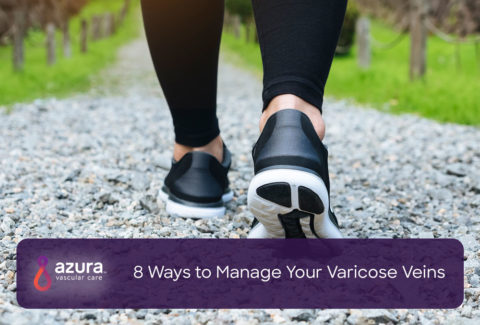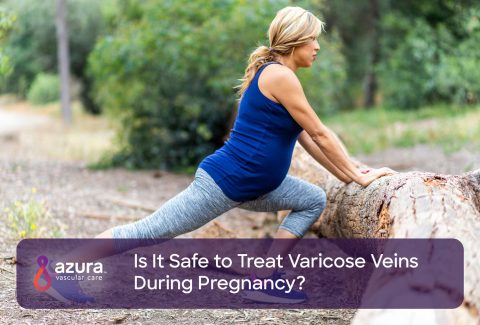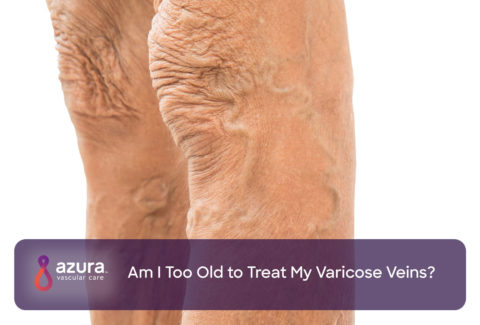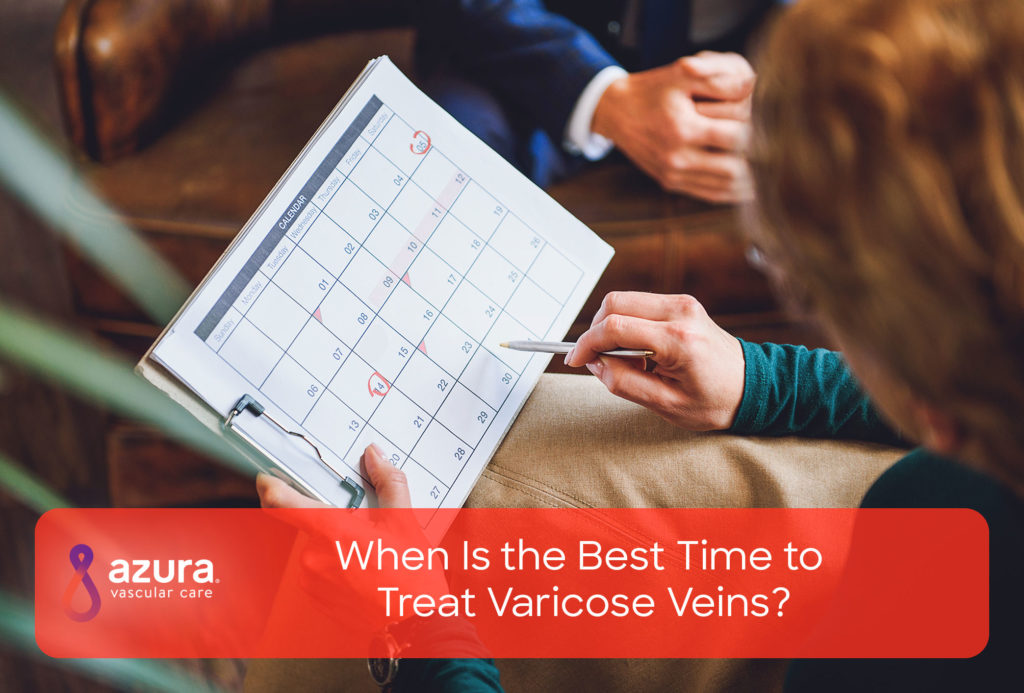
Managing varicose veins successfully requires planning and a big part of that planning means taking advantage of windows of opportunity. This includes everything from optimizing insurance coverage to choosing the best season to treat varicose veins.
At Azura Vascular Care, we treat varicose veins frequently and successfully, and we know from experience that fall and winter weather conditions help our patients better manage their symptoms and aid in their recoveries.
Three Reasons to Start Varicose Veins Treatment in Cooler Months
1. Optimal Healing
Compression stockings are a common treatment option for varicose veins. These special stockings fit snugly and help maintain blood flow, which can lessen the pain and swelling associated with varicose veins. (1)
However, no one enjoys wearing compression socks during the warmer months. Fall and winter, on the other hand, is the optimal time to feel cozy in compression stockings.
During pre- and post-operative periods, heat and ultraviolet (UV) rays should be avoided. During cooler temps, when the sun’s rays are further away, some of the sun’s harmful UV rays are blocked by the atmosphere, varying by locale. (2)
2. Fall and Winter Often Coincide with Insurance Coverage Cycles or Turnover
Often insurance coverage starts anew in January, but when you begin your treatment in the fall, insurance usually turns over just in time for surgery—if surgery is warranted—following pre-operative treatments. Insurance turnover is especially important if you have a yearly cap. (3)
Also, it is common for insurance companies to first demand a conservative treatment protocol, which can make therapy take that much longer. Beginning your assessment in the fall can position you for a great start in the New Year.
3. Fall and Winter Treatment Prepares Legs for Warmer Weather
Beginning treatment in the fall or winter prepares your legs for summer when you want to wear shorts again or spend time with friends and family at the park or beach, feeling confident and not worrying about how your legs look and feel.
Varicose Veins: What You Need to Know
In the United States, statistics show that over half of all women and approximately 40 percent of men that are 50 years of age and more suffer from varicose veins. Depending on the level of severity, these veins can be virtually unnoticeable or unsightly—bluish or purple cords, twisted and sometimes protruding.
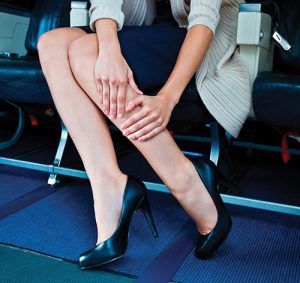
Occasionally, body weight and skin shade can mask early symptoms, and leg changes are attributed to something else—weight gain, lack of exercise, or a normal part of aging—but left untreated, varicose veins can cause: (4)
- Leg dermatitis – This skin condition results in redness, swelling and blistering. Dermatitis caused by untreated varicose veins can be particularly hard to treat because the source of the dermatitis is ongoing.
- Leg pain – Pain in the legs can include a feeling of heaviness or achiness in the legs, or lower leg swelling and burning. You might also notice increased leg pain after movement or during prolonged standing. Discoloration and itching, especially near the ankles, is another early symptom.
- Superficial thrombophlebitis – Superficial thrombophlebitis is when blood clots have formed in smaller leg veins. This is not a dangerous situation, but it may be painful.
- Venous skin ulcers – Venous skin ulcers are open sores that form on your legs, especially near the ankles. When varicose veins are left untreated, these ulcers are slow to heal—often taking months—because the underlying cause of the ulcers is ongoing. Venous skin ulcers can become infected, which may lead to potentially serious complications.
- Bleeding – Untreated varicose veins can burst and the subsequent venous bleeding may be severe. (5)
Varicose Veins Increase Risk for Complications
A comprehensive study published earlier this year found that varicose veins significantly increase the risk for life-threatening complications, including: (6)
- Deep vein thrombosis and pulmonary embolism – This is a far more serious condition than superficial thrombophlebitis. In deep vein thrombosis, a blood clot forms in a vein deep in the body—most often in the lower leg or thigh. A deep vein thrombosis has the potential to break away and travel to the lung, causing a pulmonary embolism, which is often fatal.
- Peripheral artery disease (PAD) – This is a common circulatory problem in which narrowed arteries reduce blood flow to your limbs. Avoiding these complications is crucial for long-term mobility, pain management and quality of life.
Managing Varicose Veins
Managing varicose veins goes back to taking advantage of windows of opportunity—choosing the best time to begin assessment and treatment—but successful treatment also calls for lifestyle changes in conjunction with treatment management.
According to the National Heart, Lung and Blood Institute, there are a few things you can do to optimize your treatment results and help prevent new varicose veins from forming:
- Avoid sitting or standing for long periods.
- Move your legs often, including exercising to keep blood flowing.
- If you are overweight, try losing weight to take pressure off your legs.
- Avoid tight clothing that restricts blood flow below the waist.
At Azura Vascular Care, we treat even the most complex cases of varicose veins and take a multipronged and personalized approach to varicose veins treatment. One of the options we utilize that has brought our patients fantastic results is endovenous ablation; this is an umbrella term that covers two very successful, minimally invasive treatment types: radiofrequency ablation and endovenous laser therapy.
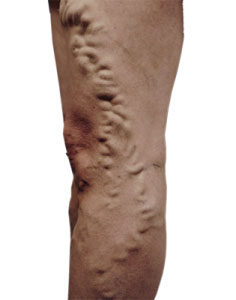
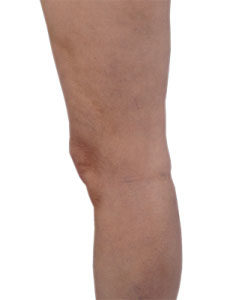
Radiofrequency ablation utilizes radiofrequency to close varicose veins for good. This procedure is usually used on smaller veins. Endovenous laser therapy uses laser light pulses to close off larger varicose veins. The good news is these treated veins are eventually reabsorbed into the body!
Along with recognizing cooler months as the best time to treat varicose veins, radiofrequency ablation and endovenous laser therapy are only two of the many minimally invasive treatment options we offer at Azura Vascular Care!
Contact Us
If you are considering varicose veins treatment, or if you need help managing your varicose veins symptoms, call 844-832-VEIN (8346) to schedule an appointment with a vascular specialist.
Sources:
(1) Kakkos, S.K., Timpilis, M., & Patrino P. (2018). Acute effects of graduated elastic compression stockings in patients with symptomatic varicose veins: A randomised double blind placebo controlled trial. European Journal of Vascular and Endovascular Surgery, 55(1):118-125.
(2) Sun Safety Monthly Average UV Index. Environmental Protection Agency. https://www.epa.gov/sunsafety/sun-safety-monthly-average-uv-index. Accessed September 25, 2018. https://www.epa.gov/sunsafety/sun-safety-monthly-average-uv-index.
(3) Annual Limits. Healthcare.gov. https://www.healthcare.gov/glossary/annual-limit/. Accessed September 25, 2018. https://www.healthcare.gov/glossary/annual-limit/.
(4) Varicose Veins. National Heart, Blood and Lung Institute. https://www.nhlbi.nih.gov/health-topics/varicose-veins. Accessed September 25, 2018. https://www.nhlbi.nih.gov/health-topics/varicose-veins.
(5) Fragkouli, K., Mitselou, A., Boumba, V.A., Siozios, G., Vougiouklakis, G.T., Vougiouklakis, T. (2012). Unusual death due to a bleeding from a varicose vein: a case report. BMC Research Notes, 2012; 5:488. doi: 10.1186/1756-0500-5-488. https://bmcresnotes.biomedcentral.com/articles/10.1186/1756-0500-5-488.
(6) Chang, S.L., Huang, Y.L., Lee, M.C., Hu, S., Hsiao, Y.C., Chang, S.W., … Chen, P.C. (2018) Association of varicose veins with incident venous thromboembolism and peripheral artery disease. JAMA 319(8):807-817. https://www.ncbi.nlm.nih.gov/pubmed/29486040.

